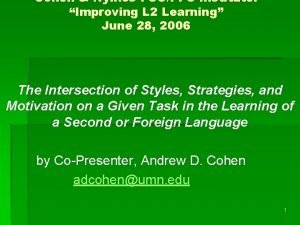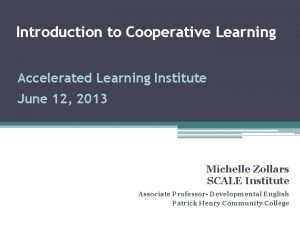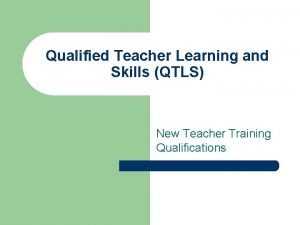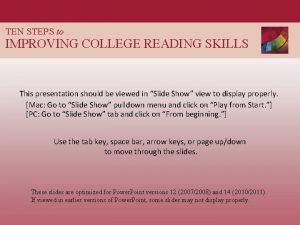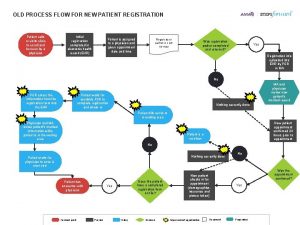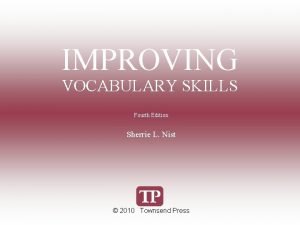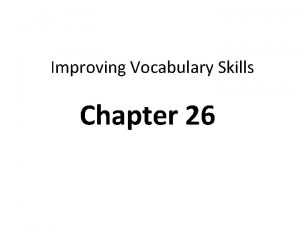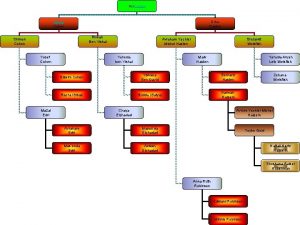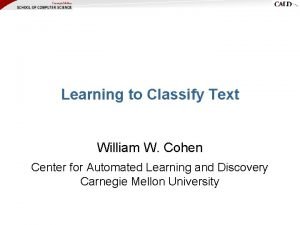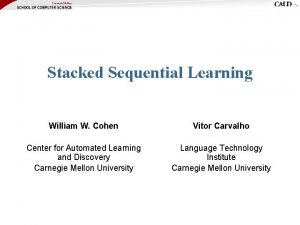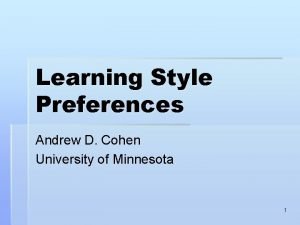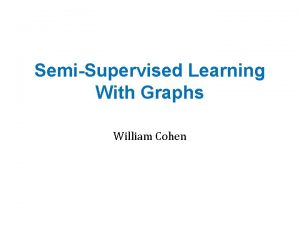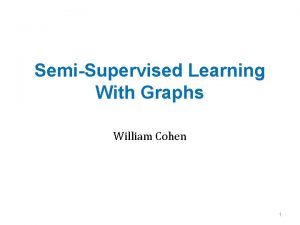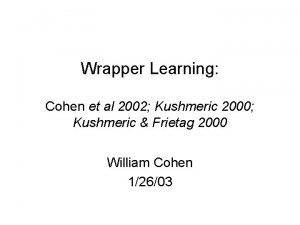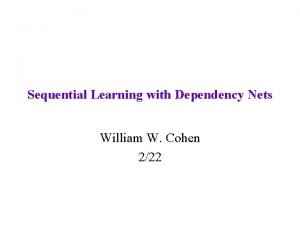Cohen Nyikos PSUPPS Institute Improving L 2 Learning





















- Slides: 21

Cohen & Nyikos PSU/PPS Institute: “Improving L 2 Learning” June 28, 2006 The Intersection of Styles, Strategies, and Motivation on a Given Task in the Learning of a Second or Foreign Language by Co-Presenter, Andrew D. Cohen adcohen@umn. edu 1

An insight from learner strategy research, efforts at learner training, and institutes for language teachers on styles- and strategies-based instruction: Learners and teachers alike get a better grasp of the concepts and their interrelationship when learning style preference, language learner strategies, and motivation are linked to performance on specific language tasks. 2

Learning Style Preferences & Language Learner Strategies These two components of the intersection have already been presented so just a quick review… 3

Learning Style Preferences The learners’ typical preferences for approaching learning. While style preferences are relatively stable, stylestretching is possible. 4

Summary of Style Preferences Sensory Style Preferences: visual auditory hands on Cognitive Style Preferences: abstract-intuitive concrete-sequential global particular synthesizing analytic field-dependent field-independent Personality-Related Style Preferences: extroverted introverted reflective impulsive open closure-oriented 5

Language Learner Strategies Learners’ conscious and semi-conscious thoughts and behaviors, having the explicit goal of improving the knowledge and understanding of the second language, as well as strategies for using the language that has been learned or for getting around gaps in language proficiency. 6

Learner’s Strategies for Dealing with Tasks § By goal: Language learning or language use strategies. § By function: Metacognitive, affective, or social strategies. § By skill: listening, speaking, reading, writing, vocabulary, or translation strategies. 7

Task Characteristics § § § authentic relevant important motivating appropriate level § useful inauthentic irrelevant unimportant not motivating not appropriate level not useful (contd. ) 8

§ § § § clear task familiar easy language teacher-initiated concrete open task independent timed unclear task unfamiliar difficult language student-initiated abstract closed task cooperative free Based largely on Skehan, P. (1998). Task-based instruction. Annual Review of Applied Linguistics, 18, 268 -286. 9

Process-Oriented Approach to Learner’s Motivation At the language level -What values and attitudes are attached to this language by the learners? 10

At the learner level – What personality traits do the learners exhibit? For example: § Confidence in their language ability? § A need for achievement in language learning? 11

At the learning situation level -- How interesting, relevant, and satisfying is the particular language course for the student? § Is the course instructor more authoritarian or more laissez-faire? § How cohesive or competitive are the students? Based on Dörnyei, Z. (2001). Motivational strategies in the language classroom. Cambridge: Cambridge University Press 12

§ Taking My Motivational Temperature on a Language Task constructed by Andrew D. Cohen & Zoltán Dörnyei, 2001. Downloadable from: http: //www. carla. umn. edu/about/profiles/Cohen Papers/Motivational_Temp. doc Learners take stock as to the motivational baggage they bring to the language learning task at hand then consider their level of motivation as they proceed to do the task, while they are doing it, and after they have finished doing it. 13

The Intersection of Styles, Strategies, & Motivation on the “Avid Sports Fans” Task § A mini-lecture in class or reading of “Avid Sports Fans” – an article of potential interest to sports fans and non-sports fans alike. 14

Activity § In this activity you will have a first-hand experience of your own style preferences, strategy choices, and motivational level on a task. § You will be exposed to a text about “Avid Sports Fans” either by listening to the points read to you or by reading them yourself. § Then you will prepare and practice presenting the material to a partner, ideally in a language other than your dominant one. 15

Intersection of Styles, Strategies, and Motivation on Task § So let’s take a look at how these three factors might intersect on this task that you just did… 16

§ More extroverted and auditory learners may prefer to listen to the mini-lecture and also, if motivation is high, to engage the instructor or peers in conversation about the topic after the talk in order to make use of certain vocabulary about sports fans as a means of learning the vocabulary. § When certain words are not clear to them, they may use the strategy of repeatedly questioning the teacher until the form, meaning, and possible functions of the words in context have become clear. 17

§ If these extroverted learners are also hands-on and visual in their style preference, they may, for example, wish to write the words written down on flash cards after class and then find native speakers who are willing to go over each flash card entry, checking for accuracy, and then using each word in a meaningful utterance, perhaps grouping several vocabulary items together in the same utterance. 18

§ Learners who are both more introverted and also prefer the auditory (as opposed to the visual and hands-on) approaches to learning new vocabulary words and phrases may be motivated to choose strategies associated with tape-recording the class presentation and playing it back several times out of class until they have understood the new vocabulary (e. g. , “diehard fan, ” “ardent, ” “avid, ” “obsession, ” “basking in a team’s glory, ” and “catharsis”). 19

§ Visual learners may wish to obtain and study a written version of the lecture (in this case, the original newspaper article), and read it rather than listening to a lecture on it – but only if the task motivates them to do so! § For them, it may be most effective to study the written text by reading through it a few times, taking written notes. § They may also choose to discuss it with other students who likewise prefer reading it – again, depending on how motivated they are. 20

Concluding Remarks § This sports fans example illustrates how a single task can be tackled in various ways, using differing language strategies, depending on the style preferences, and catering to motivational factors at the same time. § We also see that both the teacher and the learners can be involved in sustaining motivation. 21
 Psupps
Psupps Mininova torrent
Mininova torrent Improving own learning and performance examples
Improving own learning and performance examples Improving student learning one teacher at a time
Improving student learning one teacher at a time Improving student learning one teacher at a time
Improving student learning one teacher at a time Cuadro comparativo de e-learning b-learning y m-learning
Cuadro comparativo de e-learning b-learning y m-learning Leicester learning institute
Leicester learning institute Cooperative learning institute
Cooperative learning institute Invuya
Invuya Institute for learning qtls
Institute for learning qtls Denpendence
Denpendence Institute for personalized learning
Institute for personalized learning Taylor institute for teaching and learning
Taylor institute for teaching and learning Vasant narasimhan
Vasant narasimhan Ten steps to improving college reading
Ten steps to improving college reading Patient registration workflow
Patient registration workflow Bronson intranet
Bronson intranet Improving vocabulary skills 4th edition
Improving vocabulary skills 4th edition Improving vocabulary skills chapter 26
Improving vocabulary skills chapter 26 How to improve software economics
How to improve software economics Chapter 12 lesson 4 fitness safety and avoiding injuries
Chapter 12 lesson 4 fitness safety and avoiding injuries Improving software economics set 1
Improving software economics set 1
